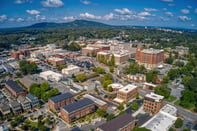Published on
Alternative Educational Programming Within a Traditional University
Ken Udas | Vice Provost of Digital Learning Initiatives, University of Idaho
Adriana D'Agostino | Assistant Director of Partnership Engagement, Brandeis University
There has been a growing dialogue about alternative and more accessible credentialing appearing within the higher education space over the past decade. Although these interests have resulted in more diverse educational programming at some colleges and universities, it is fair to say there has been more discussion than implementation. The challenges of implementing new and innovative offerings—like financial constraints, institutional resources, cultural resistance and concerns around academic integrity—are often what cause the slow-moving nature of change in our field. But the need very much exists, and institutions like Brandeis University are dedicated to collaborating with companies and organizations to develop programming that bridge the gap between academia and industry.
The Open Source Initiative (OSI) had a need to collaborate with an academic partner to develop professional development programming that meets the growing needs of organizations involved with open technologies. Patrick Masson, while serving the OSI, continuously received feedback from the OSI community that traditional programs ae not adequately preparing professionals to successfully engage in opensource projects, and mid-career professionals did not have the opportunity for professional development and reached out to the Rabb School of Continuing Studies at Brandeis University. The increased interest in Open Source Program Offices (OSPOs) was also a factor. Many organizations were promoting the idea that companies should have OSPOs, but most of the OSPO staff had software development backgrounds and educational training. Considering OSPO’s role beyond technology and engineering, other skill sets were needed.
It’s critical to raise awareness, adopt open source software and build bridges between open source communities of practice. Having software freedom through education, collaboration and infrastructure, stewarding the Open Source Definition (OSD) and preventing abuse of ideals and ethos is an important movement.
While the OSI had the subject-matter expertise and a pool of highly qualified practitioners and partners, it lacked the professional resources to create and teach high-quality courses, the infrastructure to develop and deliver those courses and the recognized academic credentials to sponsor a certification. The mission of the Rabb School of Continuing Studies at Brandeis University is to provide lifelong learning and innovative educational opportunities that align with industry needs and demands. It was believed that by working together, the OSI and Brandeis University could design and deliver a novel program to meet corporate needs, as well as students and working professionals seeking to take on new roles or broaden their career and employment options.
When the program was first launched in 2019, the course design, instructional approach, cost structure and scheduling were typical of a Continuing Education, credit-bearing, part-time master’s program like those offered within the Rabb School at Brandeis. The courses were designed for a ten-week session, cohort-based, asynchronous, yielding three graduate credits and priced accordingly. Following the initial launch, students and OSI members provided feedback that ultimately changed the program’s structure. Most potential students in this area were uninterested in earning graduate credit and simply did not have ten consecutive weeks in their schedule to dedicate to study. In short, our offering was neither convenient nor desirable for the students we wished to serve.
In responding to what we had learned and consulting with the OSI, we radically re-thought our approach to the program. While we maintained our commitment to recruiting faculty who not only have experience with open source software but who are recognized for their contributions to the community, the program was transformed from a traditional sequence of courses to more flexible and stackable course offerings. Today’s version consists of six non-credit, four-week micro-courses that can be accessed in any order with a seamless path to collect digital badges in three areas, a full-program certificate and the option to earn up to nine graduate credits through an additional assessment project. Additionally, to ensure the program’s accessibility regardless of knowledge and experience, the micro-courses were designed to be available without prerequisites. However, the program includes a complementary foundational course to ensure all learners have sufficient knowledge of basic concepts, vocabulary and open tools before the start of each micro-course. Although we redesigned many elements of the courses and program, students and instructors have responded well to the changes.
One challenge continuously discussed within the program team is our commitment to making these courses openly available. We have carefully ensured all content used in the courses is openly licensed, and the courses themselves sit within a Moodle-based learning system. Open licensing and free availability (typical notions in both Open Source Software and Open Education Resources) are not only important parts of the Open Source Technology Management (OSTM) program but of our partnership agreement with the OSI.
The OSTM program stands out as an anomaly within the Brandeis portfolio of Continuing Education programming and among other organizations offering educational programming in open source technology. There is no question that stackable offerings, flexible paths and microcredentials are an important part of the national dialogue and meet the real needs of many students and employers. We have found that, once enrolled, a majority of students succeed in their first micro-course and progress through the suite of offerings. We recognize that a pattern of success will build recognition, but the challenge continues to be rebranding a more traditional institution like Brandeis as a leader in alternative credentialing.
The six micro-courses have been fully developed and have each been offered at least once. Faculty engage in continuous iterative design and frequently speak with each other about what’s working in each class, how they’ve modified their courses to meet student needs and share recommendations. This has resulted in the seamless cycle of continuous improvement that most learning design processes seek but have difficulty achieving and sustaining.
It’s clear that traditional academic programming no longer fully accommodates employer needs and changing demographics. The structure of the Open Source Technology Management program at Brandeis University is just one example of how traditional higher education institutions can collaborate with an external entity to defy the conventional academic norms. The question remains how we can continue to challenge common conceptions of valid educational programming and produce innovative solutions to meet industry demand and need.
Disclaimer: Embedded links in articles don’t represent author endorsement, but aim to provide readers with additional context and service.
Author Perspective: Administrator



